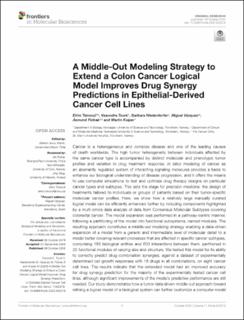| dc.contributor.author | Tsirvouli, Eirini | |
| dc.contributor.author | Touré, Vasundra | |
| dc.contributor.author | Niederdorfer, Barbara | |
| dc.contributor.author | Vazquez Garcia, Miguel | |
| dc.contributor.author | Flobak, Åsmund | |
| dc.contributor.author | Kuiper, Martin | |
| dc.date.accessioned | 2021-04-28T07:10:00Z | |
| dc.date.available | 2021-04-28T07:10:00Z | |
| dc.date.created | 2020-09-22T10:17:31Z | |
| dc.date.issued | 2020 | |
| dc.identifier.citation | Frontiers in Molecular Biosciences. 2020, 7:502573 1-19. | en_US |
| dc.identifier.issn | 2296-889X | |
| dc.identifier.uri | https://hdl.handle.net/11250/2740022 | |
| dc.description.abstract | Cancer is a heterogeneous and complex disease and one of the leading causes of death worldwide. The high tumor heterogeneity between individuals affected by the same cancer type is accompanied by distinct molecular and phenotypic tumor profiles and variation in drug treatment response. In silico modeling of cancer as an aberrantly regulated system of interacting signaling molecules provides a basis to enhance our biological understanding of disease progression, and it offers the means to use computer simulations to test and optimize drug therapy designs on particular cancer types and subtypes. This sets the stage for precision medicine: the design of treatments tailored to individuals or groups of patients based on their tumor-specific molecular cancer profiles. Here, we show how a relatively large manually curated logical model can be efficiently enhanced further by including components highlighted by a multi-omics data analysis of data from Consensus Molecular Subtypes covering colorectal cancer. The model expansion was performed in a pathway-centric manner, following a partitioning of the model into functional subsystems, named modules. The resulting approach constitutes a middle-out modeling strategy enabling a data-driven expansion of a model from a generic and intermediate level of molecular detail to a model better covering relevant processes that are affected in specific cancer subtypes, comprising 183 biological entities and 603 interactions between them, partitioned in 25 functional modules of varying size and structure. We tested this model for its ability to correctly predict drug combination synergies, against a dataset of experimentally determined cell growth responses with 18 drugs in all combinations, on eight cancer cell lines. The results indicate that the extended model had an improved accuracy for drug synergy prediction for the majority of the experimentally tested cancer cell lines, although significant improvements of the model’s predictive performance are still needed. Our study demonstrates how a tumor-data driven middle-out approach toward refining a logical model of a biological system can further customize a computer model to represent specific cancer cell lines and provide a basis for identifying synergistic effects of drugs targeting specific regulatory proteins. This approach bridges between preclinical cancer model data and clinical patient data and may thereby ultimately be of help to develop patient-specific in silico models that can steer treatment decisions in the clinic. | en_US |
| dc.language.iso | eng | en_US |
| dc.publisher | Frontiers | en_US |
| dc.rights | Navngivelse 4.0 Internasjonal | * |
| dc.rights.uri | http://creativecommons.org/licenses/by/4.0/deed.no | * |
| dc.title | A middle-out modeling strategy to extend a colon cancer logical model improves drug synergy predictions in epithelial-derived cancer cell lines | en_US |
| dc.type | Peer reviewed | en_US |
| dc.type | Journal article | en_US |
| dc.description.version | publishedVersion | en_US |
| dc.source.pagenumber | 1-19 | en_US |
| dc.source.volume | 7:502573 | en_US |
| dc.source.journal | Frontiers in Molecular Biosciences | en_US |
| dc.identifier.doi | 10.3389/fmolb.2020.502573 | |
| dc.identifier.cristin | 1832002 | |
| cristin.ispublished | true | |
| cristin.fulltext | original | |
| cristin.qualitycode | 1 | |

